What to Do When Tree Branches Hang Over Your Roof
Introduction
Trees with a large canopy add beauty to your landscaping, providing shade and a majestic appearance. However, when branches start hanging over or touching your roof, they pose potential risks to your home. In this comprehensive guide, we’ll explore the dangers, signs of risk , and the proper steps to address overhanging branches. Additionally, we’ll delve into the importance of tree care and how it contributes to the overall well-being of your property.
The Potential Risks
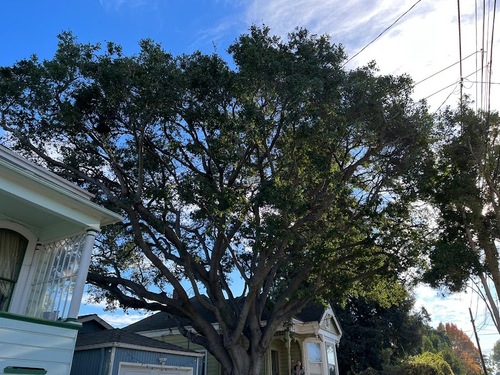
Tree Branches Hanging Over Roofs in San Francisco Bay Area
Mold Formation
When branches touch your roof, they create an environment conducive to mold growth. Mold can compromise your home’s structure and pose health risks . To mitigate this risk, it’s crucial to understand the types of mold that can develop and the potential consequences of neglecting this issue.
Types of Mold:
- Cladosporium: Commonly found on outdoor surfaces, it can trigger respiratory issues.
- Stachybotrys: Known as black mold, it can lead to severe health problems if not addressed promptly.
- Aspergillus: Found indoors and outdoors, it can cause allergies and respiratory infections.
Consequences of Mold Neglect:
- Structural Damage: Prolonged exposure to mold weakens the structure of your home .
- Health Risks: Mold spores can cause respiratory problems and allergies.
Structural Damage during Storms
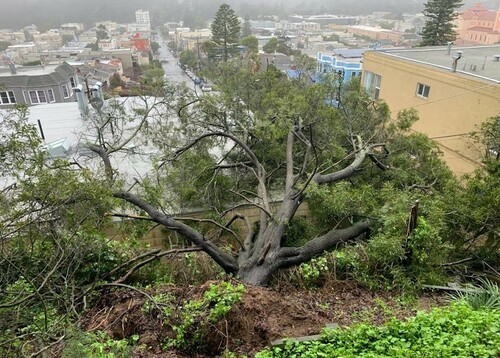
Storm Damage to Tree, SF Bay Area
Long branches become hazardous during storms, risking damage to your home. Falling branches can cause significant harm, making it crucial to address the issue promptly. Understanding the impact of storms on your property and the specific vulnerabilities introduced by overhanging branches is vital.
Storm Impact on Homes:
- Wind Damage: Strong winds can lead to structural damage, especially if branches are in direct contact with the roof.
- Water Damage: Heavy rainfall, coupled with overhanging branches, can result in water intrusion and leaks.
Vulnerabilities Introduced by Overhanging Branches:
- Increased Wind Resistance: Overhanging branches act as wind catchers , amplifying the impact of storms.
- Branch Weight: The weight of water on branches during rainstorms increases the risk of breakage.
Gutter Clogging
Leaves from overhanging branches can clog up your gutters, leading to water damage, leaks, and potential flooding. Understanding the importance of well-maintained gutters and the consequences of neglecting this aspect of home maintenance is crucial.
Consequences of Clogged Gutters:
- Water Damage: Overflowing gutters can lead to water seeping into your home’s foundation.
- Foundation Issues: Prolonged water exposure can compromise the stability of your home’s foundation.
Importance of Gutter Maintenance:
- Preventing Water Damage: Regular gutter cleaning prevents water from backing up and causing damage.
- Preserving Foundation Integrity: Well-maintained gutters contribute to a stable foundation.
Scratching and Damage

Branches Growing Near Houses
On windy days, branches in contact with your house can scrape and damage the roof and exterior. This can result in costly repairs if left unattended. Exploring the types of damage caused by overhanging branches and the potential financial implications for homeowners provides valuable insights.
Types of Damage:
- Roof Scratches: Constant contact with branches can lead to scratches, affecting the aesthetic appeal.
- Paint and Siding Damage: Overhanging branches can damage paint and siding, requiring repainting and repairs.
Financial Implications:
- Repair Costs: Ignoring overhanging branches can result in higher repair costs over time.
- Home Value: Regular maintenance enhances curb appeal and preserves home value.
Spread of Disease and Pests
Untamed branches may harbor disease and pests, affecting the health of the entire tree. Regular trimming is essential to prevent the spread of these issues. Understanding common tree diseases, pests, and the role of proper tree care in maintaining a healthy landscape is crucial.
Common Tree Diseases:
- Dutch Elm Disease: Affects elm trees, leading to wilting and eventual death.
- Oak Wilt: A fungal disease impacting oak trees, causing leaf discoloration and defoliation.
- Emerald Ash Borer: An invasive beetle that attacks ash trees, leading to tree death.
Pests and Their Impact:
- Termites: Can infest trees and spread to your home, causing structural damage .
- Scale Insects: Feed on tree sap, weakening the tree’s overall health.
Increased Risk of Fire
Overhanging branches, especially during dry seasons, can increase the risk of fire. Dead or dried-out branches provide fuel for fires, posing a threat to your home and surrounding areas. Understanding the fire risks associated with neglected tree branches emphasizes the importance of proactive measures.
Fire Risks:
- Dry Branches: Dead or dry branches become highly flammable during hot and dry conditions.
- Embers: Falling embers from nearby wildfires can ignite overhanging branches, potentially leading to a house fire.
Proactive Measures:
- Trimming Dead Branches: Regularly trim dead or dry branches to reduce fire risks.
- Creating Defensible Space: Maintain a defensible space around your home by removing flammable vegetation.
Legal Considerations
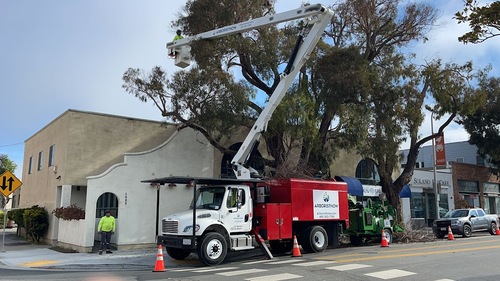
Arborist Now Trimming Branches Hanging Over Roofs
Trimming Branches Overhanging Your Property
In most areas, you have the legal right to trim branches up to the property line. However, it’s essential to check local ordinances to ensure compliance with regulations. Understanding your rights and responsibilities regarding tree trimming on your property helps you make informed decisions.
Rights of Property Owners:
- Up to Property Line: You can typically trim branches that extend onto your property up to the boundary line.
- Notification: It’s advisable to notify your neighbor before trimming branches that overhang onto your property.
Local Ordinances:
- Check Regulations: Local ordinances may specify rules and restrictions on tree trimming. Be aware of any permits or notifications required.
- Professional Assistance: Consult with local arborists or authorities for guidance on adhering to legal requirements.
Trees on Boundary Lines
When dealing with trees on boundary lines between properties, communication with neighbors is key. Shared trees may require joint responsibility, and discussing plans for tree care fosters a collaborative and amicable relationship.
Communication with Neighbors:
- Discuss Plans: Talk to neighbors before taking any action on shared trees. Collaboration ensures mutual understanding.
- Joint Responsibility: Shared trees may require joint responsibility for maintenance and care.
Legal Aspects:
- Property Line Disputes: Address any potential property line disputes through open communication or legal channels.
- Documentation: Keep documentation of agreements or discussions with neighbors regarding shared tree care.
Tree Care Methods
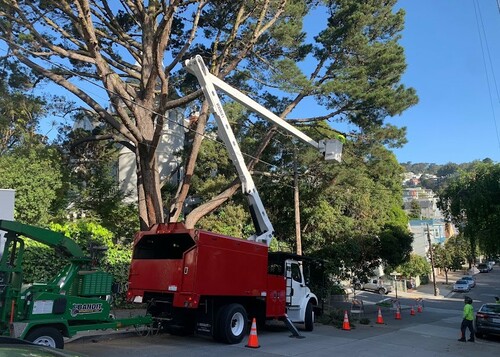
Arborist Now Pruning Trees
Crown Thinning
Crown thinning is a pruning technique that involves selectively removing branches from the tree’s crown. This method reduces the density of the crown, allowing for increased light penetration and air circulation. Crown thinning is effective in maintaining a balanced and healthy tree structure.
Benefits of Crown Thinning:
- Improved Airflow: Enhances air circulation within the crown, reducing the risk of diseases.
- Light Penetration: Allows more sunlight to reach lower branches and the surrounding landscape.
- Weight Reduction: Reduces the overall weight of the crown, minimizing stress on branches.
Crown Raising
Crown raising involves the removal of lower branches to elevate the height of the tree’s crown. This method is beneficial for enhancing clearance for buildings, walkways, and other structures. Crown raising contributes to a well-groomed and aesthetically pleasing tree.
Advantages of Crown Raising:
- Increased Clearance: Provides clearance for structures, improving safety and accessibility.
- Enhanced Visibility: Raises the canopy, allowing for better visibility of the tree’s trunk and overall form.
- Reduced Interference: Minimizes interference with buildings, vehicles, and pedestrians.
Crown Reduction
Crown reduction is a pruning technique that involves reducing the overall size and spread of the tree’s crown. This method is employed to address issues such as overhanging branches, clearance concerns, and maintaining a more manageable tree size.
Key Aspects of Crown Reduction:
- Branch Removal: Selective removal of branches to reduce crown size.
- Balanced Structure: Promotes a balanced and proportional tree structure.
- Aesthetic Appeal: Improves the overall appearance of the tree.
How to Identify Dangerous Branches
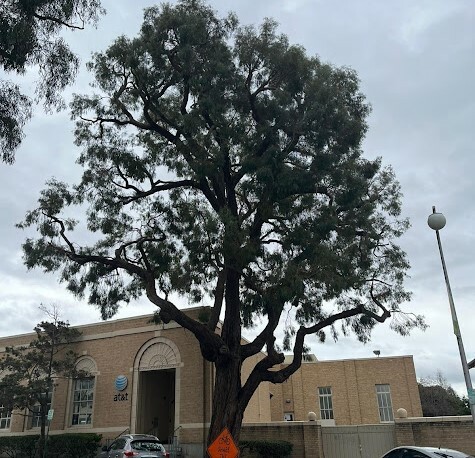
Tree Growing Near Building, San Francisco Bay Area
Any branch hanging over your home or touching the roof, windows, or the house itself should be considered a potential threat . Regular inspection is crucial to identifying and addressing these dangers promptly. Creating a checklist for homeowners to use during inspections and providing guidelines on when to seek professional assistance enhances the effectiveness of this process.
Homeowner’s Inspection Checklist:
- Visual Assessment: Look for branches in direct contact with the roof or exterior walls.
- Leaf Accumulation: Check gutters for leaf buildup, indicating overhanging branches.
- Scratch Marks: Inspect the roof for scratches caused by branches during windy conditions.
- Health Assessment: Observe the overall health of the tree, including signs of disease or pests.
- Missing Shingles: Check for missing or damaged shingles, as overhanging branches can contribute to this issue.
Guidelines for Professional Assistance:
- Frequency: Advise homeowners on the recommended frequency of professional inspections.
- Qualifications: Highlight the importance of hiring certified arborists for tree care services.
- Early Intervention: Emphasize the significance of early intervention to prevent extensive damage.
Safely Removing Hanging Branches
Removing overhanging branches requires caution to prevent accidents and further damage. While it’s possible to do it yourself, hiring a professional tree care service is recommended for a safe and effective solutionâdoing it yourself without the proper know-how can cause more damage than it’s worth. Expanding on the steps for safe removal and providing insights into the equipment and safety measures ensures a comprehensive guide for homeowners.
Steps for Safe Removal:
- Assessment: Evaluate the size, weight, and position of the branch to plan the removal process.
- Equipment: Use proper tools, such as pruning shears or a chainsaw, ensuring they are sharp and well maintained.
- Safety Gear: Wear protective gear, including gloves, safety glasses, and a helmet, to minimize the risk of injuries.
- Cutting Technique: Cut branches carefully, avoiding any sudden movements that could lead to accidents. Follow the correct cutting angles to prevent the branch from falling unpredictably.
- Professional Assistance: For those in the San Francisco Bay Area, Arborist Now provides expert tree care services. Contact us to ensure safe and efficient removal of overhanging branches.
Importance of Regular Tree Care

Tree Care in the San Francisco Bay Area
In addition to addressing immediate concerns, understanding the broader importance of regular tree care contributes to the overall health and longevity of your trees. Exploring the benefits of tree care, seasonal maintenance tips, and the role of certified arborists enhances your knowledge on maintaining a thriving landscape.
Benefits of Tree Care:
- Enhanced Tree Health: Regular pruning and trimming promote healthy growth and reduce the risk of diseases.
- Aesthetic Appeal: Well-maintained trees contribute to a visually appealing landscape.
- Property Value: Cared-for trees enhance property value and curb appeal.
Seasonal Maintenance Tips:
- Spring: Prune dead or damaged branches and inspect for signs of pests.
- Summer: Water trees during dry spells and monitor for diseases.
- Fall: Remove fallen leaves to prevent gutter clogs and disease spread.
- Winter: Protect trees from frost and wind damage.
Certified Arborists and Their Role:
- Expertise: Certified arborists have the knowledge and expertise to address specific tree care needs.
- Risk Assessment: Professionals can assess potential risks and recommend preventive measures.
- Long-Term Planning: Arborists assist in planning for the long-term health and growth of trees.
Conclusion
Don’t underestimate the risks associated with tree branches hanging over your roof. Regular inspection and timely removal by professionals are essential for safeguarding your home. Addressing these issues promptly will not only prevent damage but also contribute to the overall health and longevity of your trees. Contact Arborist Now for expert assistance in the San Francisco Bay Area and enjoy competitive rates for ensuring your home’s safety. Remember, investing in regular tree care is an investment in the beauty and well-being of your property.
Originally posted on September 1, 2019


